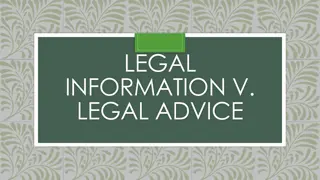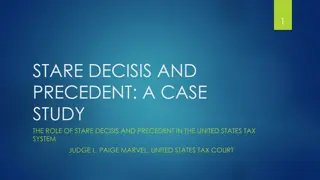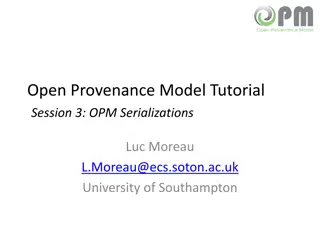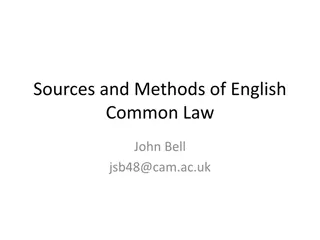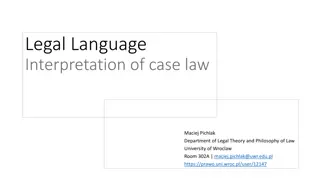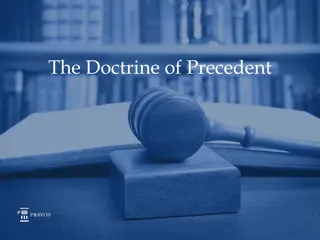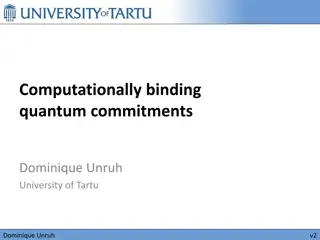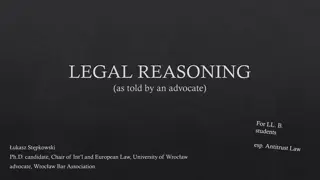Understanding the Theory of Binding Precedent in Legal English
Explore the concept of binding precedent in legal English, focusing on how similar cases are treated alike in civil law and common law systems. Learn about the history behind the establishment of binding precedents and the role of key entities like the Incorporated Council of Law Reporting. Delve into legal positivism, the importance of legal certainty, and the principles of stare decisis in vertical and horizontal senses.
Download Presentation

Please find below an Image/Link to download the presentation.
The content on the website is provided AS IS for your information and personal use only. It may not be sold, licensed, or shared on other websites without obtaining consent from the author. Download presentation by click this link. If you encounter any issues during the download, it is possible that the publisher has removed the file from their server.
E N D
Presentation Transcript
THE THEORY OF THE BINDING PRECEDENT Legal English Academic year 2018/2019 Anna Morsut
PRECEDENT LIKE CASES BE TREATED ALIKE CIVIL LAW The right decision The logical decision COMMON LAW The previous decision (no other reasons) SECONDARY SOURCE PRIMARY SOURCE
HISTORY The precedent became binding because of three events: 1. The reorganization of the higher court system 2. Birth of a semi-official organ called Incorporated Council of Law Reporting 3. Legal positivism
REORGANIZATION OF COURT SYSTEM Judicature Acts 1873-1875: High Court Court of Appeal Supreme Court This radical restructuring did much to unify the system.
INCORPORATED COUNCIL OF LAW REPORTING ICLR reports only few sentences of the higher courts, expecially: all cases which introduce, or appear to introduce, a new principle or a new rule; all cases which materially modify an existing principle or rule; all cases which settle, or materially tend to settle, a question upon which the law is doubtful; all cases which for any reason are peculiarly instructive.
LEGAL POSITIVISM Legal positivism is the thesis that the existence and content of law depends on social facts and not on its merits. LAW as a SCIENCE + need for LEGAL CERTAINTY
STARE DECISIS Stare decisis et non quieta mov re Follow the precedent despite it is wrong or unfair There are two senses of stare decisis: - Vertical sense - Horizontal sense
VERTICAL SENSE A court is always binded to follow the precedents given by superior courts: SUPREME COURT (binds) COURT OF APPEAL (binds) HIGH COURT
HORIZONTAL SENSE A court is binded to follow them precedent decisions. HIGH COURT HIGH COURT Since 1966: the High Court is always binded by its precedents; the Court of Appeal is binded, except for: contrast with a Supreme Court decision contrast between two decisions of the Court of Appeal decision given with a lacuna (with the addition of other elements there would have been a different solution) the Supreme Court is not binded, if deemed necessary.
WAYS IN WHICH PRECEDENTS CAN BE AVOIDED DISTINGUISHING depart from the facts OVERRULING depart from the law REVERSING if the lower court wrongly interpreted the law, the higher court could reverse its decision
RATIO DECIDENDI VS OBITER DICTA RATIO DECIDENDI: the point in a case which determines the judgement or the principle which the case establishes. OBITER DICTA: things included in the court s opinion that do not form a binding precedent, despite they can be strongly persuasive.
ADVANTAGES AND DISADVANTAGES PRO: Certainty; Uniformity in the law. CONTRA: Rigidity; Long time for cases to be decided.




